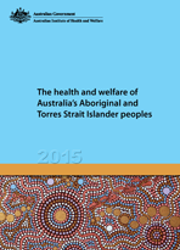Health and disability key points
Self-assessed health status
In 2012–13, 1 in 4 (24%) Indigenous Australians aged 15 and over assessed their health as fair or poor; Indigenous Australians were 2.1 times as likely as non-Indigenous Australians to report their health as fair or poor (based on age-standardised rates).
Self-assessed health status among people aged 15 and over, by Indigenous status, 2012–13 (age-standardised)
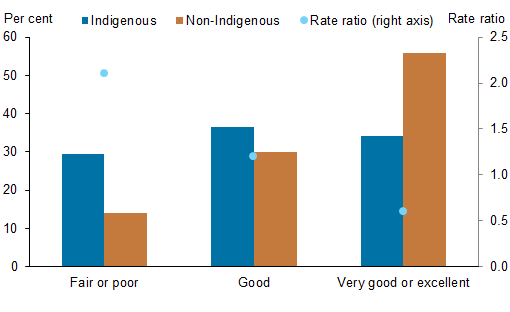
Mental health
Mental health-related problems accounted for 11% of all problems managed by general practitioners (GPs) for Indigenous patients in the 5 year period 2008–13. GPs managed mental health problems for Indigenous Australians at 1.3 times the rate for other Australians (based on age-standardised rates). Mental health-related conditions accounted for 4.4% of hospitalisations of Indigenous people in 2012–13, with Indigenous people hospitalised for such conditions at twice the rate of non-Indigenous people (based on age-standardised rates).
In the 5-year period 2008–2012, the suicide rate for Indigenous Australians was almost twice the rate for non-Indigenous Australians (based on age-standardised rates). For 15–19 year olds, the rate was 5 times as high as the non-Indigenous rate (34 and 7 per 100,000 population).
Respiratory diseases
Almost one-third (31%) of Indigenous people reported some form of long-term respiratory disease in 2012–13; Indigenous people were 1.2 times as likely as non-Indigenous people to report having this condition (based on age-standardised rates).
Respiratory diseases accounted for 5.4% of hospitalisations of Indigenous people in 2012–13, with Indigenous people hospitalised for such diseases at 2.4 times the rate of non-Indigenous people (based on age-standardised rates).
Cardiovascular disease
About 1 in 8 (13%) Indigenous Australians aged 2 and over reported having cardiovascular disease as a long-term condition in 2012–13. Indigenous people were 1.2 times as likely as non-Indigenous people to report having cardiovascular disease (based on age-standardised rates). Cardiovascular disease accounted for 3.0% of all hospitalisations of Indigenous people in 2012–13, and 8.1% of all problems managed by GPs for Indigenous patients in 2008–13.
Diabetes
In 2012–13, 11% of Indigenous adults had diabetes, while a further 4.7% were at risk of developing diabetes. Indigenous adults were 3.3 times as likely to have diabetes as non-Indigenous adults (based on age-standardised rates).
Age-standardised prevalence of diabetes based on fasting plasma glucose test among adults, by Indigenous status, 2012–13
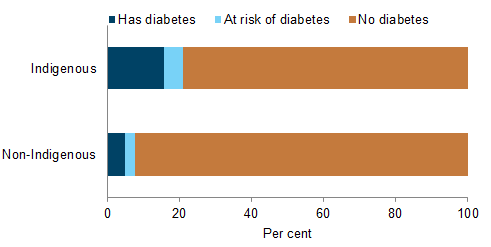
In 2008–2012, diabetes was listed as an underlying or associated cause of death in 1 in 5 (20%) Indigenous deaths.
Chronic kidney disease
In 2012–13, 1.8% of Indigenous people aged 2 and over reported having long-term kidney disease. The proportion having long-term kidney disease was 3.7 times as high as the proportion of non-Indigenous people (based on age-standardised rates).
In 2012–13, chronic kidney disease accounted for 173,423 (45%) hospitalisations of Indigenous Australians. Almost all (99%) of these hospitalisations were for same-day care involving dialysis which was the top reason for hospitalisation among Indigenous people. Indigenous people were 10 times as likely as non-Indigenous people to be hospitalised for chronic kidney disease (based on age-standardised rates).
In 2008–2012, chronic kidney disease was either an underlying or associated cause of death for 16% of Indigenous deaths.
Cancer
In the 5 year period 2005–2009, Indigenous people accounted for 1% of cancer cases diagnosed in the 4 jurisdictions with adequate Indigenous identification. The most commonly diagnosed cancers among Indigenous Australians were lung cancer (average of 130 cases per year) and breast cancer in females (95 cases per year).
In 2008–2012, the cancer death rate for Indigenous people was 1.2 times that of non-Indigenous people (based on age-standardised rates). There was a 16% increase in the cancer death rate for Indigenous people between 1998 and 2012, whereas the rate for non-Indigenous people decreased by 10%.
Injury and poisoning
Injury and poisoning was the second leading cause of hospitalisation for Indigenous Australians in 2012–13, accounting for 27,653 (7.2%) hospitalisations of Indigenous people. Of these hospitalisations, 23% were due to assault and 19% were due to accidental falls.
Causes of hospitalisations with a principal diagnosis of injury and poisoning, Indigenous people, 2012–13 (per cent)
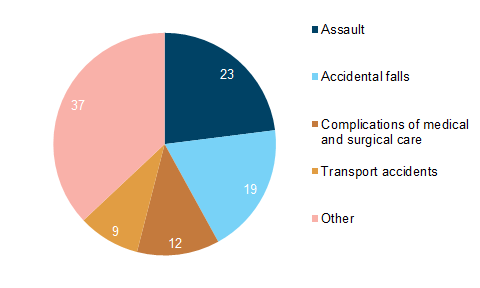
In 2008–2012, external causes of injury and poisoning accounted for 15% of deaths of Indigenous people compared with 6.1% of deaths of non-Indigenous people. The most common external causes of death for Indigenous people were suicide (4.8% of all deaths) and transport accidents (3.9%).
Other common health conditions
In 2012–13, 20% of Indigenous people reported long-term musculoskeletal diseases, 12% reported long-term ear or hearing problems, and 33% reported long-term eye or sight problems.
Disability
In 2012–13, 6.4% of Indigenous people (an estimated 41,000 people) had severe or profound disability; Indigenous Australians were twice as likely as non-Indigenous Australians to have severe or profound disability (based on age-standardised rates).
Age-standardised disability prevalence, by Indigenous status, 2012–13
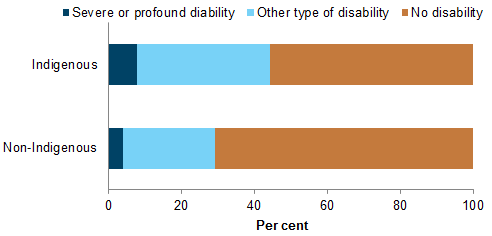
Differences by remoteness
In 2012–13:
- Indigenous people aged 15 and over in remote areas were significantly less likely to assess their health as fair or poor than those in non-remote areas (20% compared with 25%)
- Indigenous people aged 2 and over in remote areas were significantly more likely to report cardiovascular disease than those in non-remote areas (18% compared with 11%)
- Indigenous adults in remote areas were significantly more likely than those in non-remote areas to have diabetes (21% compared with 9.4%)
- the proportion of Indigenous Australians with severe or profound disability did not differ significantly between Indigenous people living in remote and non-remote areas (5.8% and 6.6%, respectively).



